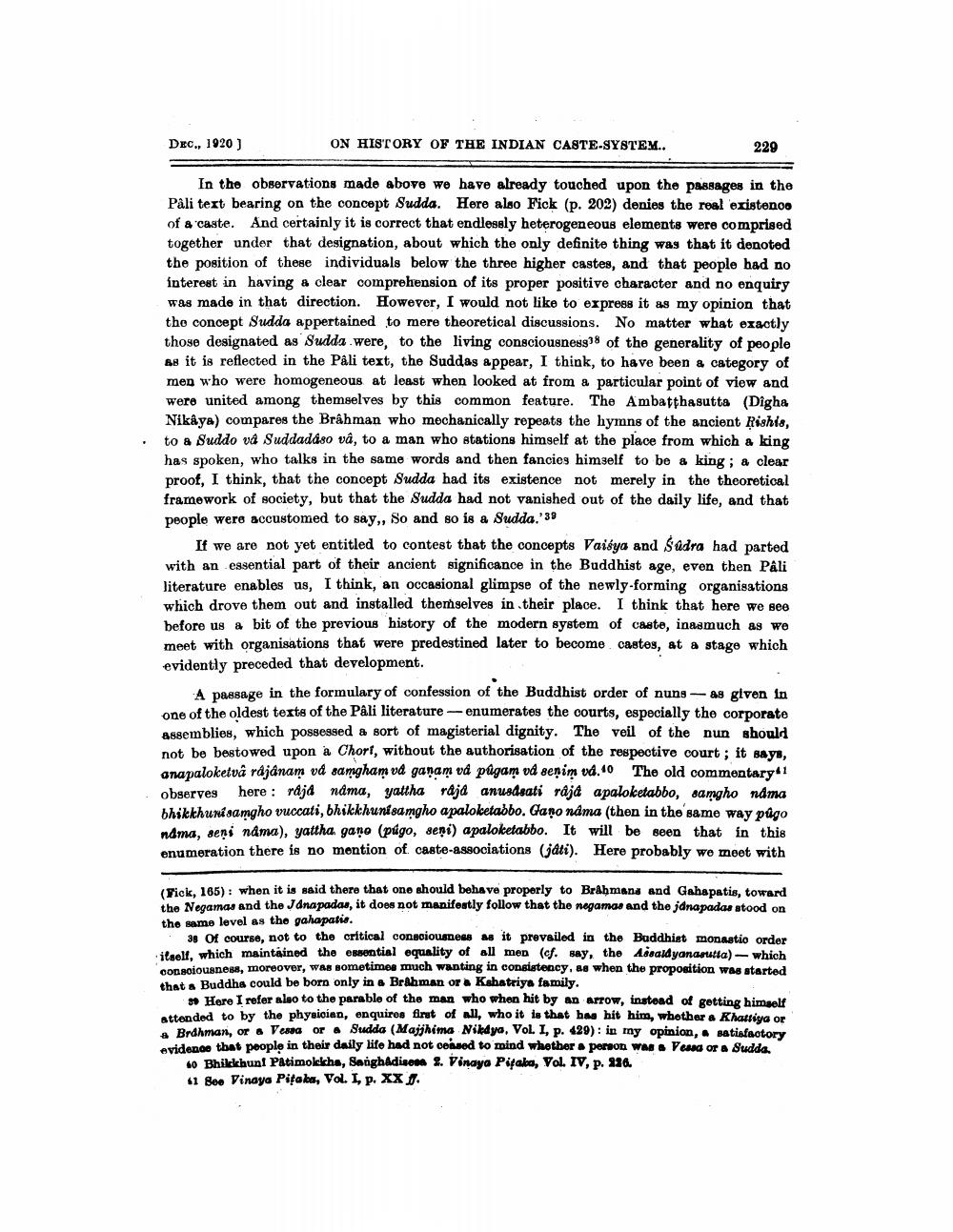________________
DEC., 1920]
ON HISTORY OF THE INDIAN CASTE-SYSTEM..
229
In the observations made above we have already touched upon the passages in the Pâli text bearing on the concept Sudda. Here also Fick (p. 202) denies the real existence of a caste. And certainly it is correct that endlessly heterogeneous elements were comprised together under that designation, about which the only definite thing was that it denoted the position of these individuals below the three higher castes, and that people had no interest in having a clear comprehension of its proper positive character and no enquiry was made in that direction. However, I would not like to express it as my opinion that the concept Sudda appertained to mere theoretical discussions. No matter what exactly those designated as Sudda were, to the living consciousness38 of the generality of people as it is reflected in the Pâli text, the Suddas appear, I think, to have been a category of men who were homogeneous at least when looked at from a particular point of view and were united among themselves by this common feature. The Ambatthasutta (Digha Nikaya) compares the Brâhman who mechanically repeats the hymns of the ancient Rishis, to a Suddo va Suddadáso vâ, to a man who stations himself at the place from which a king has spoken, who talks in the same words and then fancies himself to be a king; a clear proof, I think, that the concept Sudda had its existence not merely in the theoretical framework of society, but that the Sudda had not vanished out of the daily life, and that people were accustomed to say,, So and so is a Sudda.'39
If we are not yet entitled to contest that the concepts Vaisya and Sûdra had parted with an essential part of their ancient significance in the Buddhist age, even then Pâli literature enables us, I think, an occasional glimpse of the newly-forming organisations which drove them out and installed themselves in their place. I think that here we see before us a bit of the previous history of the modern system of caste, inasmuch as we meet with organisations that were predestined later to become castes, at a stage which evidently preceded that development.
A passage in the formulary of confession of the Buddhist order of nuns - as given in one of the oldest texts of the Pâli literature-enumerates the courts, especially the corporate assemblies, which possessed a sort of magisterial dignity. The veil of the nun should not be bestowed upon a Chort, without the authorisation of the respective court; it says, anapaloketvâ rájánam vá samgham va ganam vâ pûgam va senim v4.10 The old commentary▲1 observes here rája nama, yattha råjå anusdeati raja apaloketabbo, samgho náma bhikkhuni samgho vuccati, bhikkhunisamgho apaloketabbo. Gano nama (then in the same way pûgo náma, seni nama), yattha gano (púgo, seņi) apaloketabbo. It will be seen that in this enumeration there is no mention of caste-associations (jati). Here probably we meet with
(Fick, 165): when it is said there that one should behave properly to Brahmana and Gahapatis, toward the Negamas and the Janapadas, it does not manifestly follow that the negamas and the janapadas stood on the same level as the gahapatis.
38 Of course, not to the critical consciousness as it prevailed in the Buddhist monastic order itself, which maintained the essential equality of all men (cf. say, the Assaldyanasutta) — which consciousness, moreover, was sometimes much wanting in consistency, as when the proposition was started that a Buddha could be born only in a Brahman or a Kshatriya family.
Here I refer also to the parable of the man who when hit by an arrow, instead of getting himself attended to by the physician, enquires first of all, who it is that has hit him, whether a Khattiya or a Brahman, or a Vessa or a Sudda (Majjhima Nikdya, Vol. I, p. 429): in my opinion, a satisfactory evidence that people in their daily life had not ceased to mind whether a person was a Vessa or a Sudda.
60 Bhikkhun! Pâtimokkha, Sanghådisesa 2. Vinaya Pitaka, Vol. IV, p. 226. 1 See Vinaya Pitaka, Vol. I, p. XX J.




